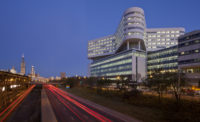 |
| Image courtesy Drexel University |
Plans call for restoring the stone-clad house and constructing a 4,600-square-foot addition. The building will double as an educational space and dorm. |

Situated on a tree-lined street on the Drexel University campus in West Philadelphia, a stone-clad dwelling circa 1872 served as the Pi Lambda Phi fraternity house for three-plus decades. In the late 1990s, however, the university shuttered the residence following an arson incident. It has sat vacant ever since.
Now, a student-run organization backed by faculty members is working to transform the three-story, 5,000-square-foot building into a hub for testing sustainable design and construction methods. The “Drexel Smart House” would also serve as a dorm that could accommodate 10 residents. In December, the university pledged $1.1 million toward the $2.5 million project, giving it a much-needed financial boost. Construction is tentatively scheduled to begin this May.
Plans call for renovating the historic building and constructing a 4,600-square-foot addition. The team has incorporated a bevy of green features, such as energy-efficient lighting, low-flow plumbing fixtures, and a graywater capture-and-reuse system. “This house is in the same style as the rest of the neighborhood, so the technology we test in our house can be transmitted throughout the community,” says Kevin Malawski, an architecture student and president of the Drexel Smart House club.
The project was hatched years ago by several students, most of whom have graduated. But momentum hasn’t waned. Joan Weiner, a business professor and the club’s primary faculty adviser, has been involved since the beginning. As she recalls, an engineering student, Jameson Detweiler, approached her in 2007 after returning from North Carolina, where he had toured a LEED Platinum dorm run by Duke University’s engineering school. He recruited students who wanted to create a similar project at Drexel. Weiner was enthusiastic but concerned that the endeavor would lose steam once Detweiler and his peers graduated. “A student might have a good idea, and it happens during his or her tenure, and then it dies,” she says. Regardless, she signed on.
The next step was finding a site. School officials suggested the old frat house and transferred ownership to the club in 2007. Students have spent the past few years designing and testing systems for the house—and they’ve made great strides. They conceived a “do-it-yourself” green roof that weighs 9 pounds per square foot, which is considerably lighter than current commercial offerings. “We want to make a system with interlocking trays that a homeowner can assemble himself,” says Malawski. In the spring of 2011, the system earned the group a $75,000 grant from the Environmental Protection Agency.
The team also won a $20,000 grant from the Pittsburgh-based Green Building Alliance for the invention of an LED that mimics sunlight over the course of a day, emitting cool light in the morning and gradually changing to yellow and red tints in the evening.
Several local firms have donated services. Mike Witkowski, a Drexel alumnus who works at McHugh Engineering Associates, is serving as a technical advisor; Poulson and Associates donated $17,000 in geotechnical engineering services; and Sean Christopher, a Drexel alum and senior construction manager at Gap Inc., is spending numerous days helping the team. Moreover, the university is offering courses based on the project. Last spring, for instance, professor Paul Schultz teamed up with Andrew Cronin, an architect at KieranTimberlake, to teach a class in which students learned how to prepare design proposals.
The Smart House has drawn praise. In a speech in April 2011, Drexel president John A. Fry called it one of the most exciting student-led projects on campus. Then, at October’s World Green Energy Symposium, the club received a NOVA Award, presented each year to notable sustainable programs. While the group continues to raise funds, they hope to finish the project by 2013. “Everyone wants to see it succeed,” says Malawski. “It’s a galvanizing project. Once people get involved, they start fighting for it.”
This story appears in the February 2012 issue of Architectural Record.
Editor’s Note: Drexel University requested that we acknowledge Provost Mark Greenberg, who was involved in the Smart House project since its inception. In 2007, engineering student Jameson Detweiler initially approached Greenberg, then dean of Drexel’s Pennoni Honors College, which greenlighted the project. Greenberg continues to support the initiative.




Post a comment to this article
Report Abusive Comment